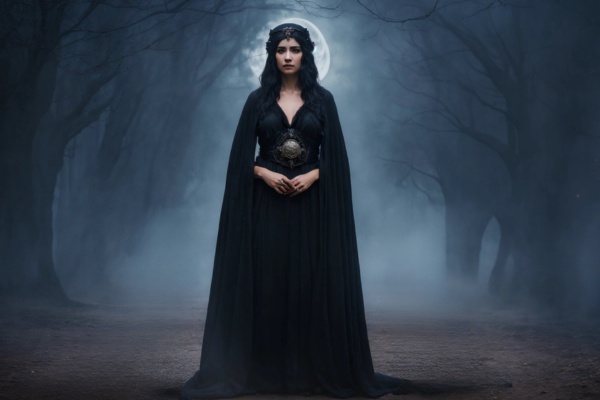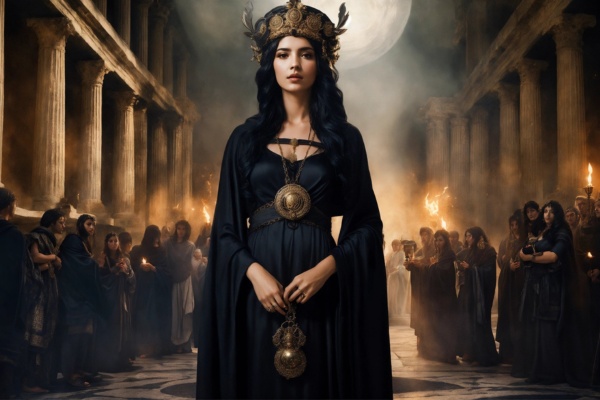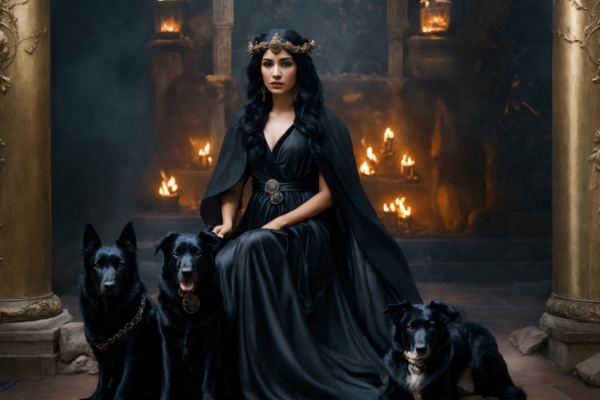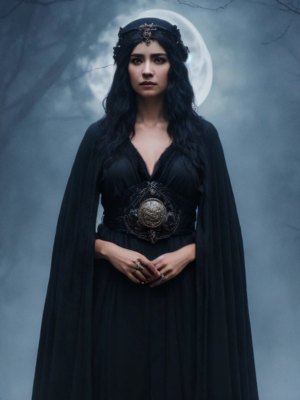Home » Goddess Hecate: Myths, Birth Story, Hymns, Personality…
Goddess Hecate: Myths, Birth Story, Hymns, Personality…
In the legendary stories from ancient Greek mythology, Hecate is the goddess of magic, witchcraft, crossroads, and even the moon and night.
She has a unique spirituality that has left a lasting impression on people till this day.
In fact, Hecate myths pop up in literature, movies, and modern spirituality.
This makes her both ancient and current at the same time.
In this article, we cut straight to the heart of her story, allowing you to learn all the important Hecate myths super-fast.
Then you’ll get to know her personality, looks, and even the hymns that made her a star in Greek mythology.
This guide keeps it simple—no technical mumbo jumbo.
Understanding the true nature of this deity has never been easier or more entertaining.
Let’s dive deep into the stories of Goddess Hecate, the one-of-a-kind, rule-breaking, Greek deity.
Who is Goddess Hecate In Greek Mythology?

Hecate is an ancient Greek goddess often associated with the moon, magic, witchcraft, and crossroads.
She’s a chthonic deity, meaning she’s linked to the underworld.
She is sometimes depicted as a triple goddess, symbolizing her rule over the sky, earth, and sea.
Some Hecate myths say she is the daughter of Titans Perses and Asteria. This makes her different from Olympian gods, as she’s able to do things they can’t.
In Greek mythology, she plays various roles, and Zeus (king of the gods) respects her.
In fact, he ends up granting her distinct honors and privileges that nobody else has.
She’s a deity who can both give blessings and unleash terror.
Goddess Hecate appears in various ancient texts like the Orphic Hymns. These hymns praise her magical prowess and important role in the divine order.
In later periods, she makes appearances in Shakespeare’s “Macbeth” and various works of modern literature and poetry.
But her allure isn’t confined to ancient Greece.
Modern Wiccan and pagan traditions often incorporate her spirituality as a goddess of witchcraft and magic.
Her imagery is widely used in astrology, tarot, and even pop culture.
Whether you’re intrigued by her historical role or her modern revival, Hecate remains a goddess whose mysterious aura continues to enthrall people.
The Story of Hecate
In both Anatolian and Greek mythology, the story of Hecate intertwines with that of ancient gods, heroes, and even witches.
But how she was born is not mentioned.
Hesiod’s “Theogony” is one of the earliest mentions of her, and she’s described as the daughter of the Titans Perses and Asteria. But nothing was mentioned about her birth.
In fact, the particulars of how Hecate was born are not mentioned in any ancient Greek texts.
Nonetheless, Hesiod gives her a pretty glowing review, outlining the various influences and roles.
According to another ancient writing from Apollonius Rhodius’ in “Argonautica” she is identified as a powerful goddess invoked by the witch Medea for her spells. No explanation of her birth in this text either.
In Hesiod’s account of her story, she was born with a divine lineage because her parents were Titans.
As a result, she inherited immense abilities and wisdom.
And as you’re about to see, the story of Goddess Hecate is fascinating and mysterious at the same time.
Hecate Myths and Legends

Let’s have a look at the most alluring Hecate myths and stories.
Hecate and Persephone
One of the more popular myths of Hecate is her rescue of Persephone, daughter of Demeter and queen of the underworld.
At the behest of Zeus, Hades had abducted Persephone to be his bride. Grief-stricken over the abduction, Demeter called upon the goddess of crossroads for assistance in finding her missing daughter.
With torches illuminating their path into the depths of hell, the goddess acted as a guide to help Demeter find Persephone amid utter darkness.
On her journey down below, she also served as beloved Mediator between mother and captor: negotiating with Hades so that he would agree to release Persephone back into her mother’s arms every 6 months – thus leading up to our modern celebration.
As both navigator and negotiator her role was crucial in establishing peace between two realms (mortal and immortal) that could have been forever at war on this matter.
Hecate and Medea
Medea is a mortal woman and is the granddaughter of Helios, the sun god. In this myth of Hecate and Medea, the goddess shows off her abilities to transfer magic over to others.
Essentially, Medea became a protégé of the goddess.
In one famous story of the two, Medea falls head over heels for Jason, the hero out to snag the Golden Fleece.
She helps him out with her magic.
Jason couldn’t have done it without her. But what does he do?
Dumps her for another woman.
Naturally, Medea doesn’t take the break-up well. She goes into full-on revenge mode.
Using the magic Hecate taught her, she wreaks havoc.
We’re talking about poisoning people and even killing her own kids.
Yeah, it gets dark.
In Ovid’s “Metamorphoses”, he mentions the goddess in different contexts, including this story of Medea.
Hecate and Galinthias
One of the more extraordinary myths of Hecate involves Galinthias, who was transformed into a polecat and becomes an attendant to the goddess after interfering with the birth of Hercules.
The story goes that Galinthias was a mortal handmaiden to Queen Alcmena, who was pregnant with Hercules.
Alcmene was having a tough time giving birth to him.
Hera, who didn’t like Hercules because he was the illegitimate son of her husband, Zeus.
Hera was jealous and tried to make Hercules’ life difficult from the moment he was born.
In fact, she sent witches to delay the birth.
Disguised as an old woman, Hecate tricked Eileithyia by telling her that the baby had already been born.
Fooled by the disguise and the false news, Eileithyia broke the spell that had prolonged the labor.
Alcmena was finally able to give birth to Hercules.
Galinthias, the loyal servant of Alcmena, was the one who had called for the goddess to help.
After the successful birth, she proudly announced that a strong boy had been born.
Angered by the deception, Hera and Eileithyia transformed Galinthias into a polecat as punishment.
The Goddess Hecate felt sorry for her. So she decided to make the transformed servant one of her sacred animals.
Role in the War Against the Titans
In the epic story where the Olympian gods fought the Titans for control of the universe, she played a crucial part.
While Zeus and his gang get most of the spotlight, let’s not forget this goddess.
She was actually born to Titans (Perses and Asteria, to be exact). So, she had every reason to side with the Titans.
But she chose the Olympians instead.
Armed with her knowledge of magic and her trusty torches, she helped the Olympians in big ways. Some myths say she used her spells to cloak the Olympians or reveal the Titans’ weaknesses.
Imagine the battlefield is dark and filled with chaos. Who do you want on your side?
Someone who can light the way, right?
Her torches weren’t just for show; they guided the Olympians through the darkness, both literally and metaphorically.
After the Olympians won, Hecate was one of the few Titans who got to keep her status and unique privileges.
Zeus even gave her an elite place in the heavens and the underworld.
Role in the War Against the Gigantes
During the War of the Gigantes, also known as the Gigantomachy, she played a pivotal role.
In this war, the Olympians fought the Gigantes, monstrous giants born from Earth.
Armed with her torches and magic, Goddess Hecate was a force to be reckoned with.
One of her most epic moments was her battle with Clytius, a fearsome Gigante.
She used her magical herbs to set him ablaze and defeated him.
Beyond combat, she was vital for strategy. Her magic could reveal weaknesses and her torches could guide troops. She wasn’t just muscle; she was the brain too.
After the Olympians won, her reputation soared.
She was already a big deal, but this victory took her to a whole new level. It cemented her role as a goddess who can seriously tip the scales in a fight.
Hecate did more than just hold a torch during this war. She helped tip the scale in favor of the Olympians.
Hecate and Circe
This is one of those Hecate myths that’s had a lasting impact over the centuries.
In some versions of this story, Scylla was once a beautiful nymph.
She caught the eye of the sea god Glaucus, but she wasn’t into him.
Desperate, Glaucus went to the sorceress Circe for a love potion.
Instead, Circe fell for Glaucus, but he rejected her.
Angry, Circe poured a potion into the sea where Scylla bathed, transforming her into a hideous monster.
Now, where does the goddess of witchcraft come in?
In some accounts, it’s said that the potion Circe used contained magical herbs from Hecate’s garden or that she learned the spell from the goddess herself.
Being the goddess of witchcraft, is often cited as the source of many powerful spells and potions in Greek mythology.
While these two weren’t best friends or enemies, there’s a link between them through the magic that transformed Scylla into a monster.
It’s another example of how Hecate’s influence pops up in different myths.
Queen Hecuba
Hecuba was not a goddess, she’s a queen. Queen of Troy, to be exact.
She’s famous for her role in the Trojan War and as the wife of King Priam. Drama followed her around like a shadow.
Hecuba had a super tough life, especially after the fall of Troy. Legend has it, she went mad and turned into a dog.
Some myths say that since she was the goddess of transformations, she had a hand in Hecuba’s drastic change. It’s like a divine intervention but in a creepy way.
In some versions of this story, Hecuba, now a dog, becomes a companion to the goddess in the underworld.
This myth of Hecate is like a weird, magical friendship born from tragedy.
It takes us from the heights of royalty to the depths of despair, with a dash of the supernatural.
It’s a haunting tale that sticks with you, making you ponder the thin line between the mortal and the mystical.
Hermes and Hecate
In ancient texts, their relationship isn’t super detailed, but they’re sometimes seen as companions or even allies. For example, in the Homeric hymn to Demeter, both Hermes and Hecate assist in the story of Persephone’s abduction.
She helps Demeter search for her daughter, while Hermes is the one who eventually brings Persephone back from the underworld.
They are both closely intertwined in Greek mythology.
Both possess knowledge of sorcery and can be considered crafty participants within ancient Greek mythological stories.
They share abilities such as being able to move between realms of existence unimpeded by boundaries – they have unrestricted access all worlds through their interactions with each other.
They each have their unique roles but overlap in “connecting different worlds”.
In modern interpretations, some people like to explore the idea of a deeper relationship between them, maybe because of these shared traits.
But as far as ancient myths go, they’re more like colleagues with similar job descriptions.
Learning about the important Hecate myths can help you understand her multi-faceted nature and influence in ancient beliefs.
Hymns to Hecate

There was no Homeric hymn to this goddess.
But she did have an Orphic hymn.
Here’s an explanation of it…
Orphic Hymn to Hecate
The Orphic Hymn to her is an ancient chant praising the Greek Goddess of the moon, earth, and sea.
She’s a versatile deity, linked to birth, life, and death.
The hymn calls her by many names and describes her capabilities. It’s often used in rituals and for saying prayers to Hecate.
It paints her as a mighty, complex figure who can both help and harm. People recite it to seek her guidance or protection.
The hymn describes her as a figure who stands at the crossroads, guiding humans through life’s twists and turns.
It states that through her light along with a key or torch in hand she stops at no boundaries for those who wander freely between mortal realms into divine space.
The Orphic Hymn to Hecate shows that she could protect people in need with powerful, mysterious magic. Even chaos couldn’t beat it. If she blessed you, you were safe, no matter what.
Homeric Hymn to Hecate
She doesn’t have a Homeric Hymn that was written exclusively for her.
She is, however, prominently featured in the “Hymn to Demeter,” which is not a Homeric Hymn but is often included in collections of them.
In this hymn, Goddess Hecate aids Demeter in her search for her daughter, Persephone.
The goddess serves as Demeter’s confidant and aide, embodying her role as a goddess of crossroads and transitions.
She helps navigate the challenging path Demeter must walk between the world of the living and the underworld.
She later continues to serve as an attendant to Persephone when she becomes the Queen of the Underworld.
What Does Hecate Look Like?

In ancient Greek art and mythology, what Hecate looks like is often depicted in various ways.
But there are some common characteristics:
She’s commonly shown holding torches and sometimes escorted by dogs. Her attire usually consists of long black robes. She was a tall, ethereal figure, radiating a mystical aura.
Her eyes are deep and dark, holding centuries of wisdom and secrets. They pierce the veil of darkness, seeing into the realms of the unknown.
It’s worth noting that her physical appearance can differ depending on the source or the time period of the artwork.
Modern interpretations of her also vary widely, from the sinister to the empowering.
In fact, today, anyone can create their own images of her.
She is a powerful and mysterious goddess of Greek mythology with an imposing physical appearance.
From her triple form to her symbolic gear, she’s not just another pretty face in the pantheon.
She’s a goddess with a mysterious and otherworldly vibe.
Now that you have an idea of what Hecate might look like, let’s examine her temperament.
Hecate’s Personality Traits

If you think she’s just a spooky deity from ancient times, think again.
Hecate personality traits often include independence, mystery, and a strong connection to the spiritual world.
She is a bit of a paradox.
On the one hand, she loves her solitude, hanging out at desolate crossroads and in the underworld.
But she’s also there when you need her, lighting the way with her torches. She’s the friend who’ll bail you out of a jam but also values her “me time.” It was a big part of her character.
Sure, she’s got that dark, mysterious vibe. But don’t let that fool you.
She feels deeply.
In a few ancient stories, the personality of Hecate truly shines through.
Remember how she helped Demeter search for Persephone?
She’s compassionate and understands the range of human emotions.
On top of all that, she isn’t afraid to go against the grain. Born to Titans but siding with the Olympians? That’s gutsy. She teaches us that it’s okay to make unconventional choices.
She’s equally at home in the heavens, on earth, and in the underworld. She shows us that embracing different parts of ourselves is not just okay, but essential.
In a world where we often feel pressured to fit into neat boxes, she shows us the influence complexity has. She’s not just one thing; she’s many things. And guess what? That’s her superpower.
As you can see, studying the different Hecate personality traits gives you insights into her role as a goddess of magic, crossroads, and the moon.
Is Goddess Hecate Good or Bad?

Whether Hecate is considered good or bad has been one of the most debated topics in ancient Greek mythology.
Throughout various mythological stories, she plays a significant role alongside gods, heroes, and witches alike.
Her involvement in these narratives showcases both her benevolent nature as well as her ability to exact justice when necessary. So she could have a dark side when the situation called for it.
Goddess Hecate, like many other deities, could bring both good and bad fortune.
She was often invoked for protection and to ward off evil spirits.
Many people regard her as benevolent due to these associations with keeping harm away from others through magic and protective energy rather than malicious intentions.
However, there are still some people who view the campaign by labeling her as ‘evil’ or menacing; mainly because she’s associated with witchcraft and darkness symbols – such as black torchlight processionals taking place during moon phases – which can evoke fear among people unfamiliar with the story behind it.
Ultimately when looking at Hecate’s role in Greek Mythology, it’s difficult not to circle back around full circle:
Her capabilities vary widely based off perception & perspective – making it difficult to judge exactly where she stands between being definitively viewed primarily ‘Good’ versus predominantly ‘Bad’, even after all these centuries later.
Hecate Greek Goddess Art
She’s been a captivating subject in art for centuries.
Traditionally, she’s depicted holding a torch, a key, and sometimes a dagger.
These Hecate symbols represent her dominion over light, knowledge, and the underworld.
In ancient Greek vases, she often appears as a young woman, but later art gives her three heads or bodies, called “triple Goddess.”
Renaissance artists got really into her mystical vibe.
They painted her as a witch-like figure, usually in dark, moody landscapes.
In these pieces, you can almost feel the mysterious energy she brings.
Fast forward to modern times, and she has become a favorite in contemporary art and pop culture.
Tattoo artists, graphic designers, and even street artists are putting their own twist on Hecate statues, figurines, and many other canvasses.
She embodies the complexities of femininity, power, and the unknown. Every brushstroke or pixel adds another layer to her ever-evolving myth. She is still a very popular deity today.
Whether it’s in classic sculptures or modern digital art, Hecate remains a big influence.
Family Tree of Goddess Hecate
First up, mom and dad. Hecate’s parents are Asteria, a Titaness of falling stars, and Perses, a Titan of destruction.
Asteria was the daughter of Titans Coeus and Phoebe and the sister of Leto, the mother of Apollo and Artemis.
She is known for turning into a quail to escape Zeus, and then into an island, called Delos, to escape Poseidon.
Her father, Perses is a Titan in Greek mythology. He’s the son of Titans Crius and Eurybia.
Perses is known for being the god of destruction.
Not a major character, but he’s part of the lineage that leads to her.
With parents like these, it’s no wonder Hecate’s powers were so strong.
Since she was the only child of her parents and didn’t have any children of her own, there weren’t other family members mentioned in ancient texts connected to her.
She didn’t have siblings.
Epithets of Hecate
Hecate is associated with a variety of powerful and meaningful epithets, which describe the different attributes and skills that she holds:
Triformis: The Triple-Formed
The epithet “Triformis” highlights Hecate’s three-fold nature. She’s often depicted with three heads or bodies, representing the crossroads between the sky, earth, and underworld. This shows her dominion over different realms and her ability to transcend boundaries.
Chthonia: Of the Earth
“Chthonia” connects her to the earth and the underworld. She’s a primal earth goddess, associated with fertile soil, but also with the darker, unseen forces beneath the earth. This epithet captures her link to nature’s cycles of life and death.
Propolos: The Guide
As “Propolos,” she acts as a guide to both gods and mortals. She lights the way in dark times and navigates souls through the underworld. This role showcases her wisdom and her understanding of both spiritual and earthly matters.
Kleidouchos: Keeper of the Keys
This nickname signifies the role of Goddess Hecate as a guardian. She holds the keys to the universe, unlocking mysteries both divine and mortal. “Kleidouchos” emphasizes her control over sacred knowledge, granting or denying access as she sees fit.
Phosphoros: The Light-Bringer
As “Phosphoros,” she carries torches, illuminating the darkness. This speaks to her dual nature: she’s both a goddess of the moon and a bringer of light. This moniker resonates with her role in guiding souls and helping people in transitions.
Enodia: Of the Ways
She is also known as “Enodia,” meaning she is connected to the roads and pathways. She guards crossroads, a literal and symbolic space where choices are made and paths diverge. This nickname highlights her role in decision-making and fate.
Each epithet paints a different facet of the goddess, making her one of the most versatile and intriguing figures in ancient mythology. Whether as a guide, a guardian, or a goddess of the elements, Hecate’s epithets reveal a complex character with far-reaching influence.
Conclusion About Goddess Hecate
So, what’s the takeaway?
Hecate is far from being a one-note goddess. She’s got layers—like an onion, but way cooler and more mystical.
From her ancient origins to her modern-day cameos, she’s a goddess who transcends time and space.
Whether you’re fascinated by her mystical prowess, drawn to her complex relationships, or just think she’s got a cool look and style, there’s something about her that grabs you.
And let’s not forget her staying power; she’s relevant today with so many people that love everything about her.
So next time you’re at a crossroads, literal or not, maybe give a nod to Hecate.
Who knows? She might just light the path for you.
Goddess Hecate myths will continue to make her a revered figure not only in mythology but also in modern culture for centuries more.

2024 All rights reserved.
